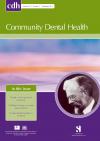Community Dental Health

- Cover Date:
- December 2012
- Print ISSN:
- 0265 539X
- Vol:
- 29
- Issue:
- 4
Editorial - Do we really need another system for recording caries? Thoughts on ICDAS
Dental caries has been described as a destructive process causing decalcification of tooth enamel leading to continued destruction of enamel and dentine and cavitation of the tooth. This definition rightly implies progression. Yet more than fifty years ago, when caries was rampant and the first rigorously conducted randomised controlled trials (RCT) of caries prophylactic agents were being conducted, it was recognised that enamel lesions (variously termed initial lesions, incipient caries, white spots etc.) could reverse, remineralise and disappear during the three-year course of a trial. Moreover, this occurred in both experimental and placebo control subjects and was apparently over and above diagnostic reversals attributable to intra-examiner error. Nowadays dental caries is not a scourge. In public health it is its ubiquity rather than its morbidity that is important, albeit some deaths still occur as complications of dental abscess (Moles, 2008). Caries is the most common disease of the mouth and remains the major concern of dentists as a cause of pain, sleep deprivation, workplace absences, and physical disfigurement. From both the public health viewpoint, and that of clinical dentistry, valid and reliable recording methods are essential. At a more specific level, instruments for recording caries are required to fulfil the information needs of four distinct, but related, clinical activities: experimental epidemiology, descriptive epidemiology, screening and case finding. Epidemiology may be loosely defined as “the study of the determinants of disease events in populations.†It deals with disease distribution, cause and control. Descriptive epidemiology describes disease incidence, prevalence and distribution for archival purposes, to investigate possible associations or to generate hypotheses for experimental verification. Experimental epidemiology deals with the clinical testing of therapeutic agents ideally by RCT. Screening is defined as “the presumptive identification of unrecognised disease or defect by the application of tests, examinations or other procedures which can be applied rapidly. Screening tests sort out apparently well persons who probably have a disease from those who probably do not†(Bhopal, 2002). Case finding is closely related to screening. However, whilst screening involves all individuals in a certain category (e.g., the dental inspection of infant school new entrants), case finding consists of investigating a smaller group of people based on the presence of risk factors (e.g., patients with a known high incidence of caries in dental practices).
- Article Price
- £15.00
- Institution Article Price
- £
- Page Start
- 258
- Page End
- 259
- Authors
Articles from this issue
- Title
- Pg. Start
- Pg. End
- Recent trends in incidence and mortality of oral and pharyngeal cancer in Schleswig-Holstein in Northern Germany
- 268
- 273
- Children’s views on the experience of a visual examination and intra-oral photographs to detect dental caries in epidemiological studies
- 284
- 288
- Cost-effectiveness models for dental caries prevention programmes among Chilean schoolchildren
- 302
- 308
